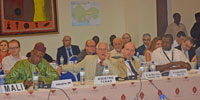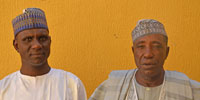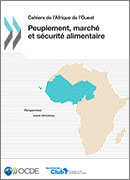Sahel and West Africa Week 2012 › SWAC Forum on Settlement, Market and Food Security
SWAC Forum on Settlement, Market and Food Security
Ouagadougou, 7 December 2012
The goal of all West African agricultural and food security policies is to feed a fast-growing and increasingly urban population. Can they actually take on board these dynamics and their mid- to long-term implications? This was the key issue of the SWAC Forum which drew on research carried out in 2011 and 2012 within the “West African Futures: Settlement, Market and Food Security” (WAF) programme. West African agriculture ministers and senior representatives of regional organisations, researchers, agricultural producer associations, civil society and the private sector discussed policy options to draw from the WAF findings. In 2013, the SWAC Secretariat will continue to capitalise on the results of this two-year programme. The objective is to contribute to the reflection on policies and strategies, and deepen some of the analyses with interested partners. A Statistical Mapping and Analytical Regional Tool (SMART) that will provide access to data and key findings will be available end March 2013.
 |
 |
 |
 |
Summary Record | WAF Synthesis | Presentations | West African Studies | Agenda
Presentations
- WAF1: A Retrospective on Settlement, Agriculture and Food Security (French)
- WAF2: Settlement Dynamics and Emerging Markets (French)
- WAF3: Markets and Interdependences
- WAF4: Agricultural Transformation (French)
- Trade and Food Security: A Global Perspective
- How does the market connection impact the geography of production? (French)
West African Studies: Settlement, Market and Food Security
 |
Settlement dynamics have reshaped West Africa’s social and economic geography over the past 60 years. The spatial changes, urbanisation and a high degree of economic concentration especially, favour the development of market-oriented agriculture. With the population of West Africa set to double by 2050, agricultural production systems will continue to experience far-reaching changes. To support this transformation, policies need to take better account of producers’ location, profiles and constraints in order to develop effective food security strategies. In order to do so, they need uniform and reliable data – not available at present –particularly for key variables such as population, agricultural production and trade. > forthcoming April 2013 | > Synthesis
|
Agenda
Welcome and registration of participants
Opening
8.30 – 9.00 am
- Mr. François-Xavier de Donnea, SWAC President
- Prof. Alhousseini Bretaudeau, CILSS Executive Secretary
- Mr. Ibrahima Diémé, UEMOA Commissioner for Rural Development, Natural Resources and the Environment
- Dr. Lapodini Marc Atouga, ECOWAS Commissioner for Agriculture, Environment and Water Resources
- H.E. Mr. Laurent Sédogo, Minister of Agriculture of Burkina Faso
- Reminder of the aims and vision of the WAF study, Mr. Laurent Bossard, Director, SWAC Secretariat (SWAC/OECD)
Session 1. Economic and spatial changes
9.00 – 9.20 am Retrospective on settlement, agriculture and food security (SWAC Secretariat)
West Africa’s demographic transition is continuing, accompanied by a spatial redistribution of populations. These settlement dynamics shape the region’s economic, social and political pathways. Agricultural achievements over the last thirty years put the region’s countries among the world’s leaders. However, ten percent of the population – some thirty million people – still suffer from chronic undernourishment. Addressing the causes of the marginalisation of the most vulnerable requires understanding the dynamics that are profoundly changing West Africa’s economic and social geography.
 |
The Statistical Mapping and Analytical Regional Tool (SMART) allows users to generate customised maps and charts from a selection of indicators for all West African countries and for the region as a whole. This interactive mapping tool will be available online early 2013. |
9.20 – 9.45 am Settlement dynamics and emerging markets (SWAC Secretariat)
The most important of these dynamics is settlement concentration, which is both a cause and a consequence of the ongoing economic, social and political changes. Urbanisation is one manifestation of them. The urban network weaves the fabric of the spatial organisation of the economy. It transforms the rural areas, with which it develops integrated trading and market spaces. The rural economy is changing and diversifying, even though the scale of the change cannot be measured from the available statistics. Value chains irrigate these spaces where, from producer to consumer, a multiplicity of urban and rural players interact. Policies need to accompany these changes and better incorporate them into food security strategies.
9.45 – 10.00 am Coffee break
10.00 – 10.45 am Discussion
10.45 – 11.00 am How does market connection change the geography of production?
The example of the Ngaoundéré (Cameroon) – Mondou (Chad) corridor, by Mr. Fofiri-Nzossie, Ngaoundéré University, Cameroon
Market connections, infrastructure and the functioning of institutions play a decisive role in the spatial configuration of markets and the changes to the agricultural system.
11.00 – 11.15 am A demo-economic tool for policy design
by Mr. Jean-Marie Cour, Consultant
The standardised database devised in the WAF study gives a dynamic and spatialised image of how the structure of settlement is changing. It provides information about long-term trends in relations between urban and rural, agricultural and non-agricultural, formal and informal populations. On this ground, demo-economic modelling could generate a new image of the interactions between economic agents and contribute to the framing and implementation of policy.
11.15 – 12.00 Discussion
12.00 – 1.30 pm Lunch
Session 2. Regional market and food security
1.30 – 2.00 pm Markets and interdependences (SWAC Secretariat)
Agricultural regional trade, being mostly informal, is only very marginally reflected in statistics. As a result, that trade is officially very small or even non-existent. Analysis of the trade in maize reveals a very different picture, albeit one that is difficult to quantify precisely at this stage. The lack of data on regional trade and consumption leads to the development of food crisis prevention and management tools of very relative reliability. The data collected and developed within the study have opened some new prospects.
2.00 – 2.15 pm Trade and food security : a global perspective
by Mr. Jonathan Brooks, Trade and Agriculture Directorate (TAD/OECD)
Trade plays a decisive role in balancing surplus and deficit zones. What factors would ensure that markets participate in food security?
2.15 – 3.00 pm Discussion
3.00 – 3.15 pm Coffee break
Session 3. The future of agricultural systems
3.15 – 3.35 pm The agrarian changes (SWAC Secretariat)
The agricultural population is likely to remain flat between 2010 and 2050, while the total population will double and the non-agricultural population will triple. West Africa could therefore experience a real agrarian revolution over the coming decades.
Family farming, which account for 80% of the total, has hitherto generated a substantial share of agricultural production by adapting to shifting demand. In the medium term, the overall production model is not likely to be very different from the model based on more or less large family farms. In the long term, however, the transformation of production systems is likely to increase in the average size of farms, the specialisation of small farms well-connected to markets and the emergence of very large farms. National and regional policies should devise targeted measures directed towards different types of producers, challenges and constraints and better deal with land availability issues and improve land management systems.
3.35 – 3.50 pm Experiences of the development of commercial agriculture
By Mr. Harouna Labo, Ferme Avicole Labo (Niger) and Mr. Mohd Sabo Nanono, Kuka Farm's Enterprise (Nigeria)
In a question-and-answer session, a producer will respond to points raised in the previous presentation and illuminate it with his experience of developing his business inside and outside Nigeria.
3.50 – 4.30 pm Discussion
4.30 – 5.00 pm Conclusion and outlook
Against this background of far-reaching and fast-moving change, how can West Africa acquire permanent mechanisms to monitor and adjust policies?
Related Documents

